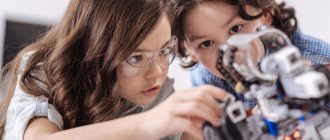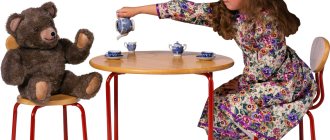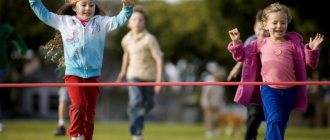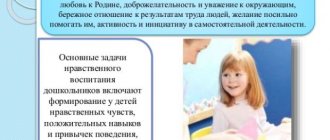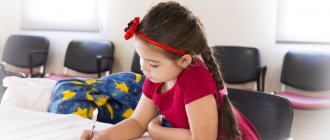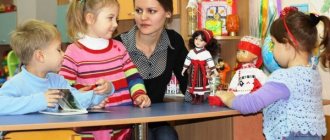Main tasks of preschool education
Kindergarten is the second social institution in a child’s life after the family. Education in kindergarten is aimed primarily at teaching children to live in society, developing the necessary skills of communication and interaction with people around them. For preschool children, communication with peers is a necessary component of harmonious development, because thanks to the developed effect of imitation, learning in a team allows you to master new knowledge and skills much faster. Many parents are frightened by the process of their child’s adaptation to kindergarten. However, the competent behavior of educators makes it possible to smooth out this process and carry it out as painlessly as possible, in contrast to the difficulties that await home children in the school community.
The tasks of preschool education in kindergarten include teaching the basic laws of communication: the child learns to seek a compromise between his desires and the interests of others, to defend his point of view and at the same time be able to restrain himself when resolving disputes. Under the supervision of a teacher, children acquire the first skills of independence, which form the basis for the child’s self-organization at home and, in the future, at school. It is especially valuable that in a children's group all these skills are formed in the most natural way - during play and in the process of communicating with other children.
Of course, kindergarten education does not in any way detract from the value of home education. However, given that modern families rarely have more than one child, kindergarten remains the most accessible source of communication and development in a team.
In addition to getting to know society, the goals of education in kindergarten are the mental, physical, moral and aesthetic development of the child. All these are necessary components for the formation of a full-fledged self-sufficient personality. The teacher’s task is to offer a wide variety of activities that will allow each student in the group to realize their potential. This could be drawing, designing and creating applications, music classes, physical education or gymnastics, and also, additionally, learning a foreign language, choreography and much more. In this way, conditions are created for the development of five basic personal potentials - cognitive, communicative, value-based, artistic and physical.
Kindergarten education program
There are a great many programs for raising children, and each kindergarten has the right to draw up its own program, but it is necessary to be guided by the requirements set out in the relevant regulations: the Federal Law “On Education”, the Model Regulations on a Preschool Educational Institution and state standards of preschool education.
In modern preschool education, such a Program has become a necessary regulatory document, on the basis of which a license is obtained, accreditation and certification of an institution, as well as the organization of additional paid educational services. The educational program in a kindergarten must justify the chosen methods of education and methods of organizing the educational process and clearly describe the main features of the educational system adopted in this kindergarten.
If a preschool education program is needed in order to formulate the goals and objectives of education, then they are implemented using various methods and technologies. Preschool education technologies make it possible to combine individual techniques and methods into an integral system and organize the upbringing of children in the most rational and effective way. Most often, educational technologies are created by educators directly based on their own experience in raising children, which guarantees the rapid achievement of the desired results.
Today, in many kindergartens, educational technologies are based on well-known educational methods, for example, Montessori, Nikitins, Doman. Each of them is focused primarily on one aspect of the child’s development, so the main task of parents when choosing a kindergarten is to carefully study the educational methods used there and determine for themselves which of the proposed systems best suits the individual characteristics of the child. On the other hand, the task of kindergarten workers is to select a set of methods that will ensure the comprehensive development of children.
The purpose and objectives of the preschool educational institution
The purpose and objectives of the preschool educational institution
The purpose and objectives of the preschool educational institution
The mission of the preschool educational institution is determined taking into account the interests of students, their parents, employees, customers, social partners and consists of:
in relation to pupils: implementation of a personality-oriented approach to each child, in providing the conditions necessary for the holistic development of the individual, the formation of competencies taking into account their individual abilities and capabilities, in accordance with the requirements of the family and the state, by ensuring the preservation, strengthening and development of mental and physical health;
in relation to parents: active inclusion of them in joint activities
as equal and equally responsible partners, a sense of understanding the importance and necessity of their role in the child’s life;
in relation to society: increasing the competitiveness of MBDOU by improving the quality of the educational process, expanding the number of educational services.
The purpose and objectives of the preschool educational institution
.
The purpose of the MBDOU activity
: implementation of the powers of local government bodies provided for by the legislation of the Russian Federation to organize the provision of public and free preschool education in basic general education programs, creating conditions for the supervision and care of children.
The main objectives of the MBDOU are
:
• protecting the lives and strengthening the physical and mental health of children, ensuring the emotional well-being of each pupil;
• ensuring the physical, intellectual, cognitive, social, aesthetic development of children, the formation of the basic foundations of the personality of each pupil;
• education, taking into account the age categories of children, citizenship, respect for human rights and freedoms, love for the surrounding nature, Motherland, family;
• involvement of parents (legal representatives)
into the educational process, the formation of a competent pedagogical position in relation to their own child;
• implementation of the Federal State Educational Standard;
• education and development of children, taking into account pronounced individual mental characteristics;
• interaction with children's families to ensure the full development of children;
• providing advisory and methodological assistance to parents (legal representatives)
on issues of education, training and development of children.
• creation of a developing subject-spatial environment and conditions for enriched activities of children
;
• implementation of the necessary correction in the personality and speech development of children through the organization of individual and collective activities
based on meaningful communication.
Priority areas of activity of preschool educational institutions
The main priority area of activity
educational institution are the artistic and aesthetic development of the personality of a preschool child.
Educational activities
The purpose of the activity
A preschool educational institution is the comprehensive formation of a child’s personality, taking into account the characteristics of his physical and mental development, individual capabilities and abilities, preparation for studying at school, the development and improvement of the educational process, the implementation of additional measures of social support for pupils and employees of a preschool educational institution.
Main subject of activity
Preschool education is the implementation of the main general educational program of preschool education in groups of general developmental orientation in various combinations in accordance with the federal state educational standard of preschool education.
Predicted result:
Formation of the leading characteristics of the child’s personality: independence, activity, determination, curiosity, communication, development of creative abilities and skills, self-esteem.
Reducing childhood morbidity, introducing a healthy lifestyle, reducing children's aggressiveness, mastering various types of movement and hardening.
Updating the content and technologies of education for students.
Building a developmental environment with a complete transition to a personality-oriented model of interaction between teachers and children.
Improving the psychophysical health of children.
The necessary conditions:
The preschool educational institution has created the necessary conditions for optimal functioning and development.
When organizing the educational process and solving assigned tasks
The preschool educational institution implements the principle of an individual – personal approach to pupils.
The staff of the preschool educational institution pays great attention to the comfort of the environment. Aesthetics, thoughtfulness, and versatility in the placement of equipment and furniture create conditions for ensuring comfort, emotional well-being, and a positive microclimate in each group.
The preschool educational institution is equipped with sufficient quantities of soft and hard equipment. There is gaming and physical education equipment, as well as methodological support.
The state of the material and technical base makes it possible to implement programs for the training and education of preschool children and to ensure the organization of life in kindergarten.
The main principle of interaction with children is the pedagogy of cooperation, a friendly attitude towards the child.
Prospects for the development of preschool educational institutions are aimed at:
Maximum satisfaction of children's interests and needs.
Increasing the level of physical fitness of children through the creation of an optimal motor mode that ensures satisfaction of activity and a rational relationship between different types of activities
, selected taking into account the age and individual characteristics of children.
Moving away from strictly regulating forms of raising and educating children, realizing the possibility of personalizing education by creating individual educational trajectories.
Enriching the range of health-improving and hardening activities, preventive procedures that help reduce morbidity in children, improving conditions for the health of children.
Search for innovative approaches in the interaction of preschool educational institutions with the family and social environment.
Improving the qualifications and professional skills of teaching staff focused on the use of new technologies aimed at creating a healthy child.
The teaching staff is aimed at a humanized, democratic approach to the process of raising and teaching children, providing psychological and pedagogical support for the development of preschool children.
Features of raising children in kindergarten
Raising preschool children is very different from subsequent education at school. Each age has its own laws according to which a child develops. In kindergarten, teachers are faced with a serious and very difficult task: to impart to children all the necessary skills and develop in them all those abilities that are impossible to do without at subsequent stages of development and education. To solve it, it is necessary to find the key for each child, to find the most suitable ways for him to present new information and learning. These can be explanations from the teacher, practical tasks or role-playing games, the main thing is that during the learning process the child has the opportunity to be independent and not just follow the instructions of the teacher. The use of various methods of education in kindergarten allows you to achieve the desired result and take into account the individual characteristics of children in the group.
One of the serious problems of preschool education is continuity between kindergarten and primary school. Traditionally, kindergartens are focused mainly on the general development of the child, while primary schools often place quite high demands on the quality of preschool education, expecting first-graders to possess the skills of mental arithmetic, reading and even writing. In addition, it is believed that schoolchildren are more disciplined and diligent than preschool children. In order to instill in children the necessary qualities, in recent years, raising children in kindergarten often includes special classes to prepare for school. Built according to the scheme of a school lesson, they psychologically prepare children for a new stage of learning. Such activities may include teaching basic arithmetic, writing and reading. At the request of parents and, as a rule, for a fee, the kindergarten management can offer foreign language classes and work with educational computer programs.
Education and training in the middle group of kindergarten. Program and methodological recommendations
Physical education
Continue work to strengthen children's health, strengthen the body and improve its functions. To develop skills and abilities to correctly perform movements in various forms of organizing children’s motor activity. To cultivate beauty, grace, expressiveness of movements. Develop independence and creativity in motor activities.
Carry out the pedagogical process based on anatomical and physiological indicators of children's development.
Indicators of physical development of children[1]
Physical development of boys from 4 to 5 years old
Physical development of girls from 4 to 5 years old
Physical education and health work
Under the guidance of medical workers, carry out a set of hardening procedures using natural factors (air, sun, water). Ensure that children stay outdoors in accordance with their daily routine.
Do morning exercises every day for 6–8 minutes.
Organize and conduct various sports games and exercises, outdoor games (in winter - sledding, sliding on ice paths, skiing; in the warm season - cycling). If conditions exist, teach children to swim.
Once a month, conduct physical education activities lasting 20 minutes; twice a year - physical education holidays (winter and summer) lasting up to 40–45 minutes.
To teach children to independently and creatively use physical education equipment and attributes for outdoor games during walks.
Physical Culture
Form correct posture.
Develop and improve children’s motor skills and abilities, the ability to creatively use them in independent motor activities.
Strengthen the ability to walk and run with coordinated movements of the arms and legs. Learn to run easily, rhythmically, energetically pushing off with your toes.
Improve the ability to crawl, climb, crawl; climb from one span of the gymnastic wall to another (right, left), through objects.
Learn to push off energetically and land correctly when jumping on two legs in place and moving forward, to navigate in space. In standing long and high jumps, learn to combine take-off with a swing of the arms, and maintain balance when landing. Practice jumping over a short rope.
Strengthen the ability to take the correct starting position when throwing, hit the ball on the ground with your right and left hands, throw and catch it with your hands (without pressing it to your chest).
Learn to ride a two-wheeled bicycle in a straight line, in a circle; skiing at a sliding step, performing turns, climbing a mountain.
Teach formations and maintaining distance while moving.
Develop psychophysical qualities: speed, endurance, flexibility, agility, etc.
Learn to play a leading role in outdoor play and be conscious of following the rules of the game.
In all forms of organizing motor activity, develop in children organization, independence, initiative, creativity, and the ability to maintain friendly relationships with peers.
Basic movements
Walking.
Walking is normal, on toes, on heels, on the outer sides of the feet, walking with high knees, small and wide steps, side steps (to the right and left). Walking in a column one at a time, two at a time (in pairs). Walking in a straight line, in a circle, along the boundaries of the hall, in a snake (between objects), scattered. Walking while performing tasks (sit down, change the position of your hands); walking alternating with running, jumping, changing direction, pace, changing the guide.
Balance exercises.
Walking between lines (distance 10–15 cm), along a line, along a rope (diameter 1.5–3 cm), on a board, gymnastic bench, beam (stepping over objects, turning, with a bag on your head, placing your foot with toes, arms to the sides). Walking on a ribbed board, walking and running up and down on an inclined board (width 15–20 cm, height 30–35 cm).
Stepping over the slats of a ladder raised 20–25 cm from the floor, over a medicine ball (over 5–6 balls placed at a distance from each other), with different hand positions.
Circling in both directions (hands on the belt).
Run.
Running is normal, on your toes, with high knees, small and wide steps. Running in a column (one by one, two by two); running in different directions: in a circle, in a snake (between objects), scattered. Running with a change of pace, with a change of leader. Continuous jogging at a slow pace for 1–1.5 minutes. Running for a distance of 40–60 m at an average speed; shuttle run 3 times 10 m; 20 m run (5.5–6 seconds; by the end of the year).
Crawling, climbing.
Crawling on all fours in a straight line (distance - 10 m), between objects, on a snake, on a horizontal and inclined board, on a bench, on a gymnastic bench on your stomach, pulling yourself up with your arms. Crawling on all fours, leaning on the feet and palms; crawling under a rope, an arc (height 50 cm) with the right and left side forward. Climbing through a hoop, climbing over a beam, a gymnastics bench. Climbing a gymnastic wall (climbing from one flight to another to the right and left).
Jumping.
Jumping in place on two legs (20 jumps 2-3 times, alternating with walking), moving forward (distance 2-3 m), turning in a circle. Jumping: legs together, legs apart, on one leg (on the right and left alternately). Jumping over a line, alternately through 4–5 lines, the distance between which is 40–50 cm. Jumping over 2–3 objects (alternately through each) with a height of 5-10 cm. Jumping from a height of 20–25 cm, in length from a place ( not less than 70 cm). Jumping with a short rope.
Rolling, throwing, catching, throwing.
Rolling balls and hoops between objects. Throwing the ball to each other from below, from behind the head and catching it (at a distance of 1.5 m); throwing the ball with both hands from behind the head and with one hand over obstacles (from a distance of 2 m). Throwing the ball up onto the ground and catching it with both hands (3-4 times in a row), hitting the ball on the ground with the right and left hands (at least 5 times in a row).
Throwing objects at a distance (at least 3.5–6.5 m), at a horizontal target (from a distance of 2–2.5 m) with the right and left hands, at a vertical target (height of the target center 1.5 m) from a distance of 1 .5–2 m.
Drill exercises.
Formation in a column one at a time, in a line, in a circle; formation into a column of two or three; alignment by landmarks; turns right, left, around; opening and closing.
Rhythmic gymnastics.
Performing familiar, previously learned exercises and cyclic movements to music.
General developmental exercises
Exercises for the hands, development and strengthening of the muscles of the shoulder girdle.
Raise your arms forward, to the sides, up (at the same time, alternately), move your arms behind your back from the following positions: arms down, hands on the belt, hands in front of the chest; swing your arms forward and back; perform circular movements with your arms bent at the elbows. Place your hands behind your head, spread them to the sides and lower them.
Raise your arms up through your sides, pressing your back tightly against the back of the chair (against the wall); lift the stick (hoop) up, lower it by the shoulders; clench and unclench your hands; Rotate your hands from the original position of the hand forward, to the sides.
Exercises to develop and strengthen back muscles and spinal flexibility.
Turn to the sides, keeping your hands on your belt, spreading them to the sides; lean forward, touching your toes with your fingers. Bend over while performing the task: putting and picking up objects from different starting positions (legs together, legs apart). Bend to the sides, keeping your hands on your belt. Roll the ball around yourself from the starting position (sitting and kneeling); transfer objects from one hand to another under a raised leg (right and left); while sitting, raise both legs above the floor; raise, bend, straighten and lower your legs to the floor from the starting positions lying on your back, sitting. Turn from your back to your stomach, holding an object in outstretched arms. Raise your arms, shoulders and head outstretched forward while lying on your stomach.
Exercises to develop and strengthen the abdominal and leg muscles.
Rise on your toes; alternately place your foot forward on your heel, on your toe; perform floods; half squats (4–5 times in a row); squats, keeping your hands on your belt, stretching your arms forward to the sides.
Alternately raise your legs with your knees bent. Walk on a stick (on a rope), resting your toes on the floor and your heels on the stick (rope). Grasp and move objects from place to place with your feet.
Static exercises.
Maintaining balance in different poses: standing on your toes, arms up; standing on one leg, hands on the belt.
Sport exercises
Sledging.
Slide down a hill on a sled, climb a mountain with a sled, brake when descending from it.
Slip.
Slide independently along icy paths.
Skiing.
Move on skis along the track with a sliding step. Make turns in place (right and left) by stepping.
Climb the slope with a straight step, half-herringbone (straight and oblique). Ski up to 500 m.
Ski games.
“Carousel in the forest”, “The farther the better”, “Vorotsa”.
Biking.
Ride a three- and two-wheeled bicycle in a straight line, in a circle. Make turns right and left.
Swimming.
Move your legs up and down while sitting in the water. Walk along the bottom on your hands forward and backward (legs extended horizontally). Squatting, immerse yourself in water up to your chin and eyes. Place your face in the water, blow on the water, and plunge your head into it. Try to swim at will.
Water games.
“Herons”, “Lumberjack in the water”, “Carousels”, “Football in the water”, “Run after the ball”, “Show your heels”, “Riding in circles”.
Hydroaerobics.
Continue to teach various movements in the water with and without music.
Outdoor games
Continue to develop children’s motor activity in games with balls, jump ropes, hoops, etc.
Develop psychophysical qualities, spatial orientation. Foster independence and initiative in organizing familiar games with a small group of peers.
Accustom to follow the rules without a reminder from the teacher. Develop children's creative abilities in games (inventing game options, combining movements).
Examples of games
With running.
“Planes”, “Colored cars”, “By the bear in the forest”, “Bird and cat”, “Find yourself a mate”, “Horses”, “Ring the rattle”, “Homeless hare”, “Traps”.
With jumping.
“Hares and the wolf”, “Fox in the hen house”, “The gray bunny is washing his face”.
With crawling and climbing.
“The Shepherd and the Flock”, “Migration of Birds”, “Kittens and Puppies”.
With throwing and catching.
“Toss - catch”, “Knock down the club”, “Ball over the net”.
For orientation in space, for attention.
“Find where it’s hidden”, “Find and remain silent”, “Who left?”, “Hide and seek”.
Folk games.
“At the Bear in the Forest”, etc.
By the end of the year, children can
• Walk and run, observing the correct technique of movements.
• Climb the gymnastic wall without missing the slats, climbing from one flight to another; crawl in different ways: leaning on your hands, knees and toes, on your feet and palms; on your stomach, pulling yourself up with your arms.
• Take the correct starting position when jumping from a standing position, land softly, and long jump from a standing position to a distance of at least 70 cm.
• Catch the ball with your hands from a distance of up to 1.5 m; take the correct starting position when throwing, throw objects in different ways with the right and left hand; hit the ball on the ground (floor) at least five times in a row.
• Perform static and dynamic balance exercises.
• Form a column one at a time, in pairs, in a circle, in a line.
• Slide independently along ice paths (length 5 m).
• Skiing at a sliding step for a distance of up to 500 m, making a turn by stepping, climbing a hill.
• Ride a two-wheeled bicycle, make right and left turns.
• Orientate yourself in space, find the left and right sides.
• Come up with options for outdoor games, perform movements independently and creatively.
• Perform simulation exercises, demonstrating beauty, expressiveness, grace, and plasticity of movements.
Education of cultural and hygienic skills
Continue to instill in children neatness and the habit of taking care of their appearance.
Develop the habit of washing yourself, washing your hands with soap before eating, when dirty, and after using the toilet.
Strengthen the ability to use a comb and handkerchief. Teach children to turn away when coughing and sneezing and to cover their mouth and nose with a handkerchief.
Improve the skills of careful eating: take food little by little, chew well, eat quietly, use cutlery correctly (spoon, fork, knife), napkin, rinse your mouth after eating.
